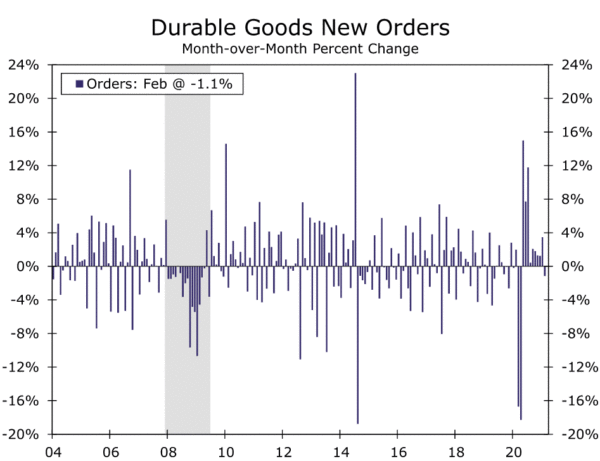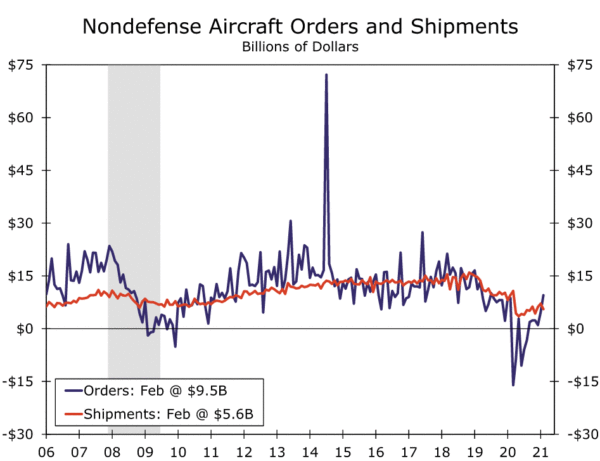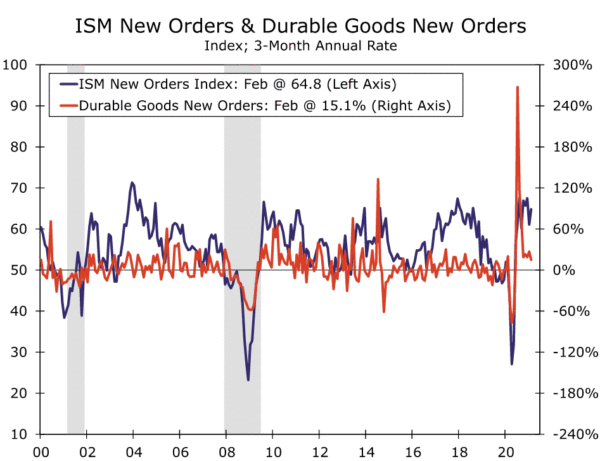The 1.1% drop in durable goods orders add to the disappointing slate of February data. While severe winter weather held down shipments last month, the manufacturing sector remains plagued by ongoing supply chain bottlenecks, which is restraining new orders. If you are looking for a bright spot in orders, tilt your head up to the sky.
Another February Flop
Durable goods orders fell 1.1% in February, even as January’s gain was revised higher. This upward revision to January and worse-than-expected February was also the case with two other marquee economic indicators: retail sales and industrial production. There is more than just weather holding back activity, particularly for manufacturing where supply chain problems are getting worse, but nothing in today’s report is enough to derail what we expect to be a strong rebound in business spending this year.
In fact, the drop in durable goods could have been worse. As we explain below, a rebound in aircraft orders was a key factor in preventing an even more disappointing headline print. A number of other categories were soft, suggesting perhaps the weather disruption reflected in the February industrial production report is also manifested here in durable goods orders. Old-line manufacturing categories were under pressure with primary metals, fabricated metals and machinery all lower after having been flat or positive in the prior month. More tech-focused businesses also saw orders fall with declines in computers and electronics products as well as communications equipment. As we describe below, this is mostly a function of getting critical inputs that have been difficult or impossible to source.
Expectations for today’s headline print ranged from -4.6% to +5.5%, which speaks to the crosscurrents in manufacturing and the added complications of February’s winter storms. Long lead times are typical for some types of durable goods, aircraft being the best example, but the pandemic has resulted in slower supplier deliveries and backlogged orders. These problems were only made worse when so much of the country was blanketed in snow or ice the way it was for part of February. The fact that shipments tumbled 3.5%, more than three times the size of the decline in orders in February, reflects this dynamic as well. Shipments can be more susceptible than orders to weather disruptions.
Aircraft Flying High Again
There is a tendency to strip out aircraft orders when the monthly numbers hit given their lumpiness and long lead times. That, however, would miss the inflection point in the aircraft sector at present. Nondefense aircraft orders and shipments rolled over months before COVID decimated travel due to the grounding of what was Boeing’s best-selling jet, the 737-MAX. Now with the MAX cleared to fly again in the United States and the end of the pandemic coming into view, aircraft orders are turning up again. In February, Boeing reported a total of 82 new orders, including 39 for the MAX. Factoring in cancellations, that is the first month of positive net orders by our calculations in more than a year. While almost every major category of durable goods orders fell last month, the value of nondefense aircraft orders soared 103%. We suspect the 21.7% drop in shipments was largely attributed to weather-related disruptions that hit other sectors. With orders recovering and airlines receiving MAX models again, we continue to expect aircraft will be a key driver of equipment spending and exports this year.
Manufacturing Has a Supply Problem
The biggest headwinds for manufacturing as we emerge from this pandemic are mostly about manufacturers getting the stuff they need. From high-tech inputs like semiconductors to basic industrial supplies like steel and even finding the skilled labor to staff the factories, businesses have a supply problem. The downside of that is price pressures and the potential for profit squeeze. The upshot though is that activity and sentiment are soaring.
This is evident in the ISM index, where a 64.8 print for new orders in February presaged today’s gain. Some of the regional Fed surveys have been remarkably strong as well. Last week we learned that the Philadelphia Fed’s Business Outlook Survey came in at its highest level since before the first Rocky movie was filmed there in the mid-1970s.
Once global supply chains normalize and businesses can get their hands on the input components they need, we are forecasting a faster rebound for manufacturing than what occurred in the wake of the past two recessions.
















